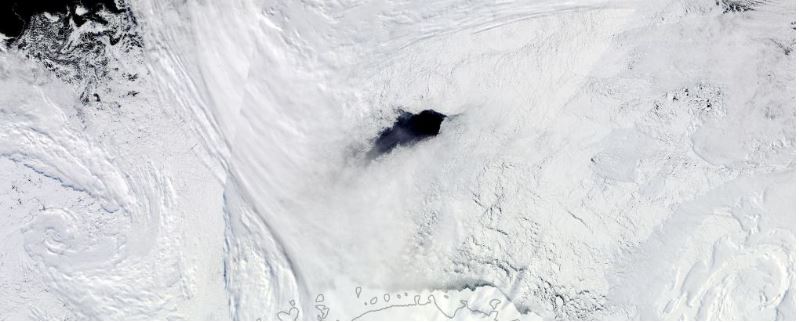


 2:42:30
2:42:30  2024-05-02
2024-05-02  1525
1525

The last pieces of a puzzle that has baffled scientists for decades have finally fallen into place.
In the winter ice crusting over the Antarctic Weddell Sea, near a submerged peak named Maud Rise, a huge hole sometimes opens and gapes, exposing the dark, cold waters below. First spotted in 1974, it doesn't appear every year, leading scientists to wonder about the specific conditions needed to produce it.
In the years since the hole's reappearance in 2016 and 2017, a solution has slowly come together. Using a combination of satellite imagery, floating autonomous instruments, seals wearing hats, and computational modeling, the answers are finally in, and they involve wind dragging layers of water to create what's known as an Ekman spiral.
"Ekman transport," says oceanographer Alberto Naveira Garabato of the University of Southampton in the UK, "was the essential missing ingredient that was necessary to increase the balance of salt and sustain the mixing of salt and heat towards the surface water."
Holes in the Antarctic sea ice, known as polynyas, are frequently seen close to the shore, used as windows by marine mammals such as seals and whales to catch their breath.
Farther out to sea, they're far less common. In fact, the recurring hole known as the Maud Rise polynya has had scientists scratching their heads since it was first spotted in a satellite image half a century ago.
In 1974, the giant hole was around the size of New Zealand. It returned in 1975 and 1976, though after that it only returned briefly and weakly, until scientists suspected it might be gone for good.
Then, in 2016 and 2017, it returned with a vengeance; a hole in the ice the size of Maine.
The Maud Rise polynya of 2017 marked the largest and longest-lived example of the phenomenon since the 1970s, so scientists got to work. A compilation of the data, collected by the aforementioned sources, revealed that a number of different factors contributed, and all needed to line up in just the right way to produce the polynya.
One factor was a circular current around the Weddell Sea which happened to be particularly strong in 2016 and 2017, resulting in an upwelling of warm, particularly salty water.
"This upwelling helps to explain how the sea ice might melt," explain oceanographer Fabian Roquet of the University of Gothenburg in Sweden.
"But as sea ice melts this leads to a freshening of the surface water, which should in turn put a stop to the mixing. So, another process must be happening for the polynya to persist. There must be an additional input of salt from somewhere."
Salt can significantly lower the freezing point of water, so if the water in the polynya is particularly saline, that could explain the hole's persistence. So the team went back to the data, as well as computational models of the ocean, to figure out where the additional salt came from.
They determined that turbulent eddies generated as the Weddell current flows around Maud Rise transport salt to the top of the seamount.
From there, Ekman transport takes over. This occurs when wind blows over the ocean's surface, creating drag. Water is not only pulled along, but also deflected out sideways like the wake on a boat, causing the water to spiral like a screw. As the top layer of water moves away with the wind, water comes up from underneath to replace it.
In the case of the Maud Rise polynya, this upwelling water brings with it the buildup of salt hovering around Maud Rise, keeping the hole from freezing over.
This key can help scientists predict what's going to happen to Antarctic sea ice in the future, a matter of grave concern for the global climate. Climatologists are already predicting that Antarctic winter winds are going to grow stronger and more frequent, which could see more frequent huge polynyas in the years to come.
In turn, this could have implications for the world's oceans.
"The imprint of polynyas can remain in the water for multiple years after they've formed," says climatologist Sarah Gille of the University of California San Diego "They can change how water moves around and how currents carry heat towards the continent. The dense waters that form here can spread across the global ocean."
Reality Of Islam |
|

Labor short

A new ultra

Batteries p
 9:3:43
9:3:43
 2018-11-05
2018-11-05
10 benefits of Marriage in Islam
 7:5:22
7:5:22
 2019-04-08
2019-04-08
benefits of reciting surat yunus, hud &
 9:45:7
9:45:7
 2018-12-24
2018-12-24
advantages & disadvantages of divorce
 11:35:12
11:35:12
 2018-06-10
2018-06-10
 6:0:51
6:0:51
 2018-10-16
2018-10-16
 8:19:41
8:19:41
 2018-06-21
2018-06-21
 1:16:44
1:16:44
 2018-05-14
2018-05-14
 11:11:59
11:11:59
 2023-02-01
2023-02-01
 10:55:53
10:55:53
 2022-06-13
2022-06-13
 7:45:39
7:45:39
 2018-06-21
2018-06-21
 12:47:1
12:47:1
 2022-12-20
2022-12-20
bahlool & the throne of haroun rashid
 8:20:35
8:20:35
 2018-06-21
2018-06-21
 5:41:46
5:41:46
 2023-03-18
2023-03-18
| LATEST |